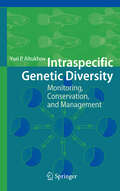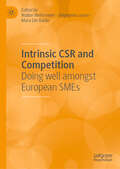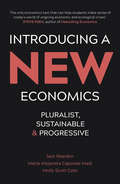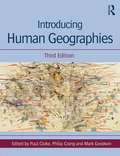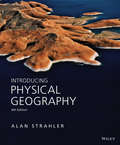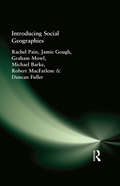- Table View
- List View
Intraspecific Genetic Diversity: Monitoring, Conservation, and Management
by Yuri Petrovich AltukhovPopulation and evolutionary genetics have been quickly developing ?elds of biological research over the past decades. This book compiles our current understanding of genetic processes in natural populations. In addition, the book provides the author’s original ideas and concepts based on the data obtained by himself and his close coworkers. The author introduces his pioneering concept of population genetic stability,and much of thebook is concerned with the factors and conditions of such stability. Why does genetic stability matter so much? Altukhov argues that the sustainable use of natural resources, including genetic resources of popu- tions, critically depends on the maintenance of their stability. The preser- tion of well-adapted genetic characteristics from one generation to the next is essential for this stability. Traditionally, population genetics has been - cusedonevolution andthe role of evolutionary factorsinshapinggenetic structures of populations. While the idea of a population as a dynamic unit of evolution has been widely accepted, the signi?cance of genetic stability and its implications for the long-term survival of populations and species have not been fully appreciated.
Intrinsic CSR and Competition: Doing well amongst European SMEs
by Mara Del Baldo Walter Wehrmeyer Stéphanie LooserThis edited book is at the intersection of the discussion on family-owned business, the CSR agenda and company competition in Europe. The authors contribute to the debates on corporate social responsibility by arguing that formal management systems are not the one-size-fits-all solution they are typically presented to be. Exploring alternative interpretations of the profile environmental management activities have in SMEs, the book evaluates the way in which cultural and ethical values are embedded in European SMEs in order to drive and orientate CSR successfully without following the mainstream ‘systems’ approach. It addresses several values of thought within the CSR debate such as intrinsic CSR, the role of virtue ethics and moral theory in corporate culture, environmental sustainability and vision-driven CSR. Focusing on a European perspective, the book heuristically explores an alternative model for the integration of CSR, innovation dynamics and economic success driven by intrinsic values rather than extrinsic post-decision rationalisations.
Intrinsic Geodesy
by A. MarussiThe science of Geodesy has undergone far-reaching changes in the last half century. The impact of new technology, from electromag netic distance measurements to the use of artificial satellites, has been great, and is still largely to be felt. These changes have forced the practitioners of the ancient art of Earth measurement to alter their way of thinking about the space that surrounds us, something fundamentally more difficult than absorbing a new technology. A key influence in this modem change in geodetic thinking has been the work of Antonio Marussi, in his scientific publications from 1947 onwards, through his students and collaborators at the Uni versity of Trieste, and in the series of symposia on three-dimensional Geodesy which he organised with his great friend and collaborator, Martin Hotine. His influence on the latter, stemming from their first meeting at the General Assembly of the International Association of Geodesy in Oslo in 1948, was remarkable in itself, leading as it did to the ultimate publication of Hotine's Mathematical Geodesy in 1969.
The Intrinsic Value of Endangered Species (Routledge Studies in Ethics and Moral Theory)
by Ian A. SmithWhy save endangered species without clear aesthetic, economic, or ecosystemic value? This book takes on this challenging question through an account of the intrinsic goods of species. Ian A. Smith argues that a species’ intrinsic value stems from its ability to flourish—its organisms continuing to reproduce successfully and it avoiding extinction—which helps to demonstrate a further claim, that humans ought to preserve species that we have endangered. He shows our need to exercise humility in our relations with endangered species through the preservation of their intrinsic goods, which in turn rectifies our degradation of their importance. Unique in its appeal to virtue ethics and to species concepts, The Intrinsic Value of Endangered Species is an important resource for scholars working in environmental ethics and the philosophy of biology.
The Intrinsic Value of Endangered Species (Routledge Studies in Ethics and Moral Theory)
by Ian A. SmithWhy save endangered species without clear aesthetic, economic, or ecosystemic value? This book takes on this challenging question through an account of the intrinsic goods of species. Ian A. Smith argues that a species’ intrinsic value stems from its ability to flourish—its organisms continuing to reproduce successfully and it avoiding extinction—which helps to demonstrate a further claim, that humans ought to preserve species that we have endangered. He shows our need to exercise humility in our relations with endangered species through the preservation of their intrinsic goods, which in turn rectifies our degradation of their importance. Unique in its appeal to virtue ethics and to species concepts, The Intrinsic Value of Endangered Species is an important resource for scholars working in environmental ethics and the philosophy of biology.
Introducing a New Economics: Pluralist, Sustainable and Progressive
by Molly Scott Cato Maria Alejandra Madi Jack ReardonIntroducing a New Economics is a groundbreaking textbook that heralds a revolution in the teaching of economics. Students and lecturers alike are rejecting the narrow curricula and lack of intellectual diversity that characterise the mainstream. They demand that the real world should be brought back into the classroom, insisting that this is the only way to confront the current crisis. With a firm commitment to theoretical, methodological and disciplinary pluralism, the renowned authors of this book challenge the current hegemony head-on. This unique textbook reflects a new ethos of economics education, highlighting sustainability and justice in its discussion of work, employment, power, capital, markets, money and debt. This volume is a work of progressive, heterodox economics that will set the standard for years to come.
Introducing a New Economics: Pluralist, Sustainable and Progressive
by Jack Reardon Maria Alejandra Madi Molly Scott CatoIntroducing a New Economics is a groundbreaking textbook that heralds a revolution in the teaching of economics. Students and lecturers alike are rejecting the narrow curricula and lack of intellectual diversity that characterise the mainstream. They demand that the real world should be brought back into the classroom, insisting that this is the only way to confront the current crisis. With a firm commitment to theoretical, methodological and disciplinary pluralism, the renowned authors of this book challenge the current hegemony head-on. This unique textbook reflects a new ethos of economics education, highlighting sustainability and justice in its discussion of work, employment, power, capital, markets, money and debt. This volume is a work of progressive, heterodox economics that will set the standard for years to come.
Introducing Architectural Tectonics: Exploring the Intersection of Design and Construction
by Chad SchwartzIntroducing Architectural Tectonics is an exploration of the poetics of construction. Tectonic theory is an integrative philosophy examining the relationships formed between design, construction, and space while creating or experiencing a work of architecture. In this text, author Chad Schwartz presents an introductory investigation into tectonic theory, subdividing it into distinct concepts in order to make it accessible to beginning and advanced students alike. The book centers on the tectonic analysis of twenty contemporary works of architecture located in eleven countries including Germany, Italy, United States, Chile, Japan, Bangladesh, Spain, and Australia and designed by such notable architects as Tadao Ando, Herzog & de Meuron, Kengo Kuma, Olson Kundig, and Peter Zumthor. Although similarities do exist between the projects, their distinctly different characteristics – location and climate, context, size, program, construction methods – and range of interpretations of tectonic expression provide the most significant lessons of the book, helping you to understand tectonic theory. Written in clear, accessible language, these investigations examine the poetic creation of architecture, showing you lessons and concepts that you can integrate into your own work, whether studying in a university classroom or practicing in a professional office.
Introducing Architectural Tectonics: Exploring the Intersection of Design and Construction
by Chad SchwartzIntroducing Architectural Tectonics is an exploration of the poetics of construction. Tectonic theory is an integrative philosophy examining the relationships formed between design, construction, and space while creating or experiencing a work of architecture. In this text, author Chad Schwartz presents an introductory investigation into tectonic theory, subdividing it into distinct concepts in order to make it accessible to beginning and advanced students alike. The book centers on the tectonic analysis of twenty contemporary works of architecture located in eleven countries including Germany, Italy, United States, Chile, Japan, Bangladesh, Spain, and Australia and designed by such notable architects as Tadao Ando, Herzog & de Meuron, Kengo Kuma, Olson Kundig, and Peter Zumthor. Although similarities do exist between the projects, their distinctly different characteristics – location and climate, context, size, program, construction methods – and range of interpretations of tectonic expression provide the most significant lessons of the book, helping you to understand tectonic theory. Written in clear, accessible language, these investigations examine the poetic creation of architecture, showing you lessons and concepts that you can integrate into your own work, whether studying in a university classroom or practicing in a professional office.
Introducing General Relativity
by Mark Hindmarsh Andrew LiddleIntroducing General Relativity An accessible and engaging introduction to general relativity for undergraduates In Introducing General Relativity, the authors deliver a structured introduction to the core concepts and applications of General Relativity. The book leads readers from the basic ideas of relativity—including the Equivalence Principle and curved space-time—to more advanced topics, like Solar System tests and gravitational wave detection. Each chapter contains practice problems designed to engage undergraduate students of mechanics, electrodynamics, and special relativity. A wide range of classical and modern topics are covered in detail, from exploring observational successes and astrophysical implications to explaining many popular principles, like space-time, redshift, black holes, gravitational waves and cosmology. Advanced topic sections introduce the reader to more detailed mathematical approaches and complex ideas, and prepare them for the exploration of more specialized and sophisticated texts. Introducing General Relativity also offers: Structured outlines to the concepts of General Relativity and a wide variety of its applications Comprehensive explorations of foundational ideas in General Relativity, including space-time curvature and tensor calculus Practical discussions of classical and modern topics in relativity, from space-time to redshift, gravity, black holes, and gravitational waves Optional, in-depth sections covering the mathematical approaches to more advanced ideas Perfect for undergraduate physics students who have studied mechanics, dynamics, and Special Relativity, Introducing General Relativity is an essential resource for those seeking an intermediate level discussion of General Relativity placed between the more qualitative books and graduate-level textbooks.
Introducing General Relativity
by Mark Hindmarsh Andrew LiddleIntroducing General Relativity An accessible and engaging introduction to general relativity for undergraduates In Introducing General Relativity, the authors deliver a structured introduction to the core concepts and applications of General Relativity. The book leads readers from the basic ideas of relativity—including the Equivalence Principle and curved space-time—to more advanced topics, like Solar System tests and gravitational wave detection. Each chapter contains practice problems designed to engage undergraduate students of mechanics, electrodynamics, and special relativity. A wide range of classical and modern topics are covered in detail, from exploring observational successes and astrophysical implications to explaining many popular principles, like space-time, redshift, black holes, gravitational waves and cosmology. Advanced topic sections introduce the reader to more detailed mathematical approaches and complex ideas, and prepare them for the exploration of more specialized and sophisticated texts. Introducing General Relativity also offers: Structured outlines to the concepts of General Relativity and a wide variety of its applications Comprehensive explorations of foundational ideas in General Relativity, including space-time curvature and tensor calculus Practical discussions of classical and modern topics in relativity, from space-time to redshift, gravity, black holes, and gravitational waves Optional, in-depth sections covering the mathematical approaches to more advanced ideas Perfect for undergraduate physics students who have studied mechanics, dynamics, and Special Relativity, Introducing General Relativity is an essential resource for those seeking an intermediate level discussion of General Relativity placed between the more qualitative books and graduate-level textbooks.
Introducing Geographic Information Systems with ArcGIS: A Workbook Approach to Learning GIS
by Michael D. KennedyAn integrated approach that combines essential GIS background with a practical workbook on applying the principles in ArcGIS 10.0 and 10.1 Introducing Geographic Information Systems with ArcGISintegrates a broad introduction to GIS with a software-specific workbook for Esri's ArcGIS. Where most courses make do using two separate texts, one covering GIS and another the software, this book enables students and instructors to use a single text with an integrated approach covering both in one volume with a common vocabulary and instructional style. This revised edition focuses on the latest software updates—ArcGIS 10.0 and 10.1. In addition to its already successful coverage, the book allows students to experience publishing maps on the Internet through new exercises, and introduces the idea of programming in the language Esri has chosen for applications (i.e., Python). A DVD is packaged with the book, as in prior editions, containing data for working out all of the exercises. This complete, user-friendly coursebook: Is updated for the latest ArcGIS releases—ArcGIS 10.0 and 10.1 Introduces the central concepts of GIS and topics needed to understand spatial information analysis Provides a considerable ability to operate important tools in ArcGIS Demonstrates new capabilities of ArcGIS 10.0 and 10.1 Provides a basis for the advanced study of GIS and the study of the newly emerging field of GIScience Introducing Geographic Information Systems with ArcGIS, Third Edition is the ideal guide for undergraduate students taking courses such as Introduction to GIS, Fundamentals of GIS, and Introduction to ArcGIS Desktop. It is also an important guide for professionals looking to update their skills for ArcGIS 10.0 and 10.1.
Introducing Geographic Information Systems with ArcGIS: A Workbook Approach to Learning GIS
by Michael D. KennedyAn integrated approach that combines essential GIS background with a practical workbook on applying the principles in ArcGIS 10.0 and 10.1 Introducing Geographic Information Systems with ArcGISintegrates a broad introduction to GIS with a software-specific workbook for Esri's ArcGIS. Where most courses make do using two separate texts, one covering GIS and another the software, this book enables students and instructors to use a single text with an integrated approach covering both in one volume with a common vocabulary and instructional style. This revised edition focuses on the latest software updates—ArcGIS 10.0 and 10.1. In addition to its already successful coverage, the book allows students to experience publishing maps on the Internet through new exercises, and introduces the idea of programming in the language Esri has chosen for applications (i.e., Python). A DVD is packaged with the book, as in prior editions, containing data for working out all of the exercises. This complete, user-friendly coursebook: Is updated for the latest ArcGIS releases—ArcGIS 10.0 and 10.1 Introduces the central concepts of GIS and topics needed to understand spatial information analysis Provides a considerable ability to operate important tools in ArcGIS Demonstrates new capabilities of ArcGIS 10.0 and 10.1 Provides a basis for the advanced study of GIS and the study of the newly emerging field of GIScience Introducing Geographic Information Systems with ArcGIS, Third Edition is the ideal guide for undergraduate students taking courses such as Introduction to GIS, Fundamentals of GIS, and Introduction to ArcGIS Desktop. It is also an important guide for professionals looking to update their skills for ArcGIS 10.0 and 10.1.
Introducing Human Geographies
by Andrew Williams Paul Cloke Mark Goodwin Junxi Qian Kelly DombroskiIntroducing Human Geographies is a ‘travel guide’ into the academic subject of human geography and the things that it studies. The coverage of the new edition has been thoroughly refreshed to reflect and engage with the contemporary nature and direction of human geography. This updated and much extended fourth edition includes a diverse range of authors and topics from across the globe, with a completely revised set of contributions reflecting contemporary concerns in human geography. Presented in four parts with a streamlined structure, it includes over 70 contributions written by expert international researchers addressing the central ideas through which human geographers understand and shape their subject. It maps out the big, foundational ideas that have shaped the discipline past and present; explores key research themes being pursued in human geography’s various sub-disciplines; and identifies emerging collaborations between human geography and other disciplines in the areas of technology, justice and environment. This comprehensive, stimulating and cutting-edge introduction to the field is richly illustrated throughout with full colour figures, maps and photos.The book is designed especially for students new to university degree courses in human geography across the world, and is an essential reference for undergraduate students on courses related to society, place, culture and space.
Introducing Human Geographies
Introducing Human Geographies is a ‘travel guide’ into the academic subject of human geography and the things that it studies. The coverage of the new edition has been thoroughly refreshed to reflect and engage with the contemporary nature and direction of human geography. This updated and much extended fourth edition includes a diverse range of authors and topics from across the globe, with a completely revised set of contributions reflecting contemporary concerns in human geography. Presented in four parts with a streamlined structure, it includes over 70 contributions written by expert international researchers addressing the central ideas through which human geographers understand and shape their subject. It maps out the big, foundational ideas that have shaped the discipline past and present; explores key research themes being pursued in human geography’s various sub-disciplines; and identifies emerging collaborations between human geography and other disciplines in the areas of technology, justice and environment. This comprehensive, stimulating and cutting-edge introduction to the field is richly illustrated throughout with full colour figures, maps and photos.The book is designed especially for students new to university degree courses in human geography across the world, and is an essential reference for undergraduate students on courses related to society, place, culture and space.
Introducing Human Geographies, Third Edition
by Paul Cloke Philip Crang Mark GoodwinIntroducing Human Geographies is the leading guide to human geography for undergraduate students, explaining new thinking on essential topics and discussing exciting developments in the field. This new edition has been thoroughly revised and updated and coverage is extended with new sections devoted to biogeographies, cartographies, mobilities, non-representational geographies, population geographies, public geographies and securities. Presented in three parts with 60 contributions written by expert international researchers, this text addresses the central ideas through which human geographers understand and shape their subject. Part I: Foundations engages students with key ideas that define human geography’s subject matter and approaches, through critical analyses of dualisms such as local-global, society-space and human-nonhuman. Part II: Themes explores human geography’s main sub-disciplines, with sections devoted to biogeographies, cartographies, cultural geographies, development geographies, economic geographies, environmental geographies, historical geographies, political geographies, population geographies, social geographies, urban and rural geographies. Finally, Part III: Horizons assesses the latest research in innovative areas, from mobilities and securities to non-representational geographies. This comprehensive, stimulating and cutting edge introduction to the field is richly illustrated throughout with full colour figures, maps and photos. These are available to download on the companion website, located at www.routledge.com/9781444135350.
Introducing Human Geographies, Third Edition
by Paul Cloke Philip Crang Mark GoodwinIntroducing Human Geographies is the leading guide to human geography for undergraduate students, explaining new thinking on essential topics and discussing exciting developments in the field. This new edition has been thoroughly revised and updated and coverage is extended with new sections devoted to biogeographies, cartographies, mobilities, non-representational geographies, population geographies, public geographies and securities. Presented in three parts with 60 contributions written by expert international researchers, this text addresses the central ideas through which human geographers understand and shape their subject. Part I: Foundations engages students with key ideas that define human geography’s subject matter and approaches, through critical analyses of dualisms such as local-global, society-space and human-nonhuman. Part II: Themes explores human geography’s main sub-disciplines, with sections devoted to biogeographies, cartographies, cultural geographies, development geographies, economic geographies, environmental geographies, historical geographies, political geographies, population geographies, social geographies, urban and rural geographies. Finally, Part III: Horizons assesses the latest research in innovative areas, from mobilities and securities to non-representational geographies. This comprehensive, stimulating and cutting edge introduction to the field is richly illustrated throughout with full colour figures, maps and photos. These are available to download on the companion website, located at www.routledge.com/9781444135350.
Introducing Just Sustainabilities: Policy, Planning, and Practice (Just Sustainabilities)
by Julian AgyemanThis unique and insightful text offers an exploration of the origins and subsequent development of the concept of just sustainability.Introducing Just Sustainabilities discusses key topics, such as food justice, sovereignty and urban agriculture; community, space, place(making) and spatial justice; the democratization of our streets and public spaces; how to create culturally inclusive spaces; intercultural cities and social inclusion; green-collar jobs and the just transition; and alternative economic models, such as co-production. With a specific focus on solutions-oriented policy and planning initiatives that specifically address issues of equity and justice within the context of developing sustainable communities, this is the essential introduction to just sustainabilities.
Introducing Large Rivers
by Avijit GuptaAn accessible introduction to large rivers, including coverage of the geomorphology, hydrology, ecology, and environments of large river systems This indispensible book takes a structured and global approach to the subject of large rivers, covering geomorphology, hydrology, ecology, and anthropogenic environment. It offers a thorough foundation for readers who are new to the field and presents enlightening discussions about issues of management at the worldwide scale. The book also examines possible future adaptations that may come about due to climate change. The book has benefitted from contributions by Professor W.J. Junk on the ecology of floodplains and Professor Olav Slaymaker on the large arctic rivers. Introducing Large Rivers is presented in three parts. Part 1 provides an introduction to the world’s large rivers and their basins. It covers source, transfer, and storage of their water and sediment; Pleistocene inheritance; the ecology of channels and floodplains; deltas; and more. Several large rivers are discussed in the next part. These include the Amazon Mississippi, Nile, Ganga-Brahmaputra System, Mekong, and Yangtze. The last part examines changes in large rivers and our management of river systems. It studies anthropogenic alterations such as land use and deforestation in large river basins; structural control systems like dams and reservoirs on channels; and ecological changes. It finishes with chapters on the management of large rivers, covering both technical and political aspects, and the future of the world’s big river systems. Introducing Large Rivers is ideal as an introductory textbook on large rivers for future earth and environmental scientists and river managers. It will also benefit advanced undergraduate and graduate students studying geography, geology, ecology, and river management.
Introducing Large Rivers
by Avijit GuptaAn accessible introduction to large rivers, including coverage of the geomorphology, hydrology, ecology, and environments of large river systems This indispensible book takes a structured and global approach to the subject of large rivers, covering geomorphology, hydrology, ecology, and anthropogenic environment. It offers a thorough foundation for readers who are new to the field and presents enlightening discussions about issues of management at the worldwide scale. The book also examines possible future adaptations that may come about due to climate change. The book has benefitted from contributions by Professor W.J. Junk on the ecology of floodplains and Professor Olav Slaymaker on the large arctic rivers. Introducing Large Rivers is presented in three parts. Part 1 provides an introduction to the world’s large rivers and their basins. It covers source, transfer, and storage of their water and sediment; Pleistocene inheritance; the ecology of channels and floodplains; deltas; and more. Several large rivers are discussed in the next part. These include the Amazon Mississippi, Nile, Ganga-Brahmaputra System, Mekong, and Yangtze. The last part examines changes in large rivers and our management of river systems. It studies anthropogenic alterations such as land use and deforestation in large river basins; structural control systems like dams and reservoirs on channels; and ecological changes. It finishes with chapters on the management of large rivers, covering both technical and political aspects, and the future of the world’s big river systems. Introducing Large Rivers is ideal as an introductory textbook on large rivers for future earth and environmental scientists and river managers. It will also benefit advanced undergraduate and graduate students studying geography, geology, ecology, and river management.
Introducing Physical Geography
by Alan H. StrahlerIntroducing Physical Geography, 6th Edition is known for its clear writing, distinctive photos and illustrations and a strong supplements program. The text continues its tradition as a great book to help non-science readers visualize and understand earth processes and learn the basic language of physical geography. The new edition features a strengthened "Eye on Global Change" coverage and coverage of the geographers tool box.
Introducing Quantitative Geography: Measurement, Methods and Generalised Linear Models
by Larry O'BrienThe purpose of quantitative geography is to train geographers in numeracy and in the vital skills of data collection, processing and interpretation. Introducting Quantitative Geography describes quantification from first principles to cover all the key elements of quantitative geography. No previous knowledge of statistical procedures is assumed. Worked examples and computer analyses are used to explain measurement, scale, description, models and modelling. Building on this, the book explores and clarifies the intellectual and practical problems presented by numerical and technological advances in the field.
Introducing Quantitative Geography: Measurement, Methods and Generalised Linear Models
by Larry O'BrienThe purpose of quantitative geography is to train geographers in numeracy and in the vital skills of data collection, processing and interpretation. Introducting Quantitative Geography describes quantification from first principles to cover all the key elements of quantitative geography. No previous knowledge of statistical procedures is assumed. Worked examples and computer analyses are used to explain measurement, scale, description, models and modelling. Building on this, the book explores and clarifies the intellectual and practical problems presented by numerical and technological advances in the field.
Introducing Social Geographies
by Rachel Pain Jamie Gough Graham Mowl Michael Barke Robert MacFarlene Duncan Fuller`Introducing Social Geographies' is a major new text offering a comprehensive and up-to-date introduction to this important area of human geography. It presents a broad overview of social geography, clearly outlining the key theoretical and political positions, and making extensive use of examples to show how these frameworks can be used to analyse real social issues.The book is ideal for undergraduates first encountering social geography and includes topic overviews, summaries of key points, critiques, boxed case studies and suggestions for further reading.
Introducing Social Geographies (A\hodder Arnold Publication)
by Rachel Pain Jamie Gough Graham Mowl Michael Barke Robert MacFarlene Duncan Fuller`Introducing Social Geographies' is a major new text offering a comprehensive and up-to-date introduction to this important area of human geography. It presents a broad overview of social geography, clearly outlining the key theoretical and political positions, and making extensive use of examples to show how these frameworks can be used to analyse real social issues.The book is ideal for undergraduates first encountering social geography and includes topic overviews, summaries of key points, critiques, boxed case studies and suggestions for further reading.
